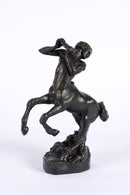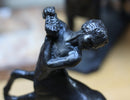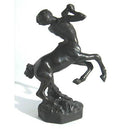Description
Ophelia Gordon Bell was born in London in 1915 but spent much of her childhood in the Lake District. In her mid teens Ophelia was well on the way to becoming an accomplished artist in her own right, studying at Regent Street Polytechnic Sculpture School in London where she worked with stone, wood, metal, clay and plaster. By the age of 23 Ophelia had already exhibited her work at the Royal Academy, the Royal Glasgow Institute of Fine Arts and the Society of Portrait Sculptors.
In her later years Ophelia turned her attentions to the infinitely more pastoral and rural scenes that surrounded her: scenes that inspired her to craft her highly sought after sculptural studies of local shepherds with their sheep and farmers with their dogs.
This piece is a mythological subject produced in a classical style while Ophelia was a sculpture student at Regent Street Polytechnic in London in the early 1930's. The myth relates that Cheiron was among the gentlest, kindest and most learned of creatures, and was tutor to several Greek heroes, including Achillies, Jason and Heracles. This sculpture shows the young centaur, full of life and vitality, pan pipes to his lips. The sculpture has the Greek name Xeipon inscribed on the base.
This piece was made using a process called cold casting, which is a process of mixing urethane resin with a metal powder and pouring the mixture into a mould to obtain a casting that gives the appearance of solid metal. There are different techniques used to achieve a metallic finish with metal powders such as bronze, brass, aluminium, nickel-silver and copper being used depending on the effect desired. The metal cold cast process is faster and much less expensive when compared with foundry casting of molten metal (lost wax process).
To make a cold casting, metal powder is mixed into the resin until the mixture is thick and creamy. The mixture is then slush-cast (poured into a mould and rolled around or brushed in to keep the mould face coated, until the mixture sets.) The remaining cavity is then filled with plain resin, resin mixed with a different filler to give the casting body and and dimensional stability, or foam.
For example, to make a cold cast bronze similar to our sculptures, a mixture of bronze powder, casting resin and liquid pigment is made. Adding a dark pigment (black or dark brown) to the resin/bronze powder mixture gives the final casting added definition and dimension. The proportions of resin, bronze powder and pigment used vary depending on the desired effect.
Height 26cm Weight 1.05kg
Payment & Security
Your payment information is processed securely. We do not store credit card details nor have access to your credit card information.








